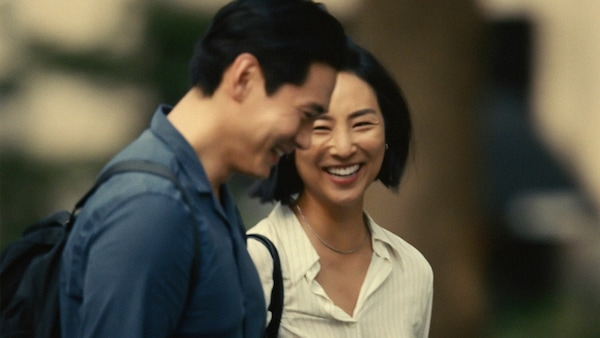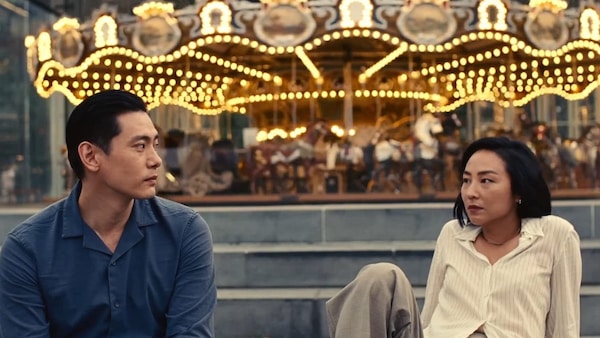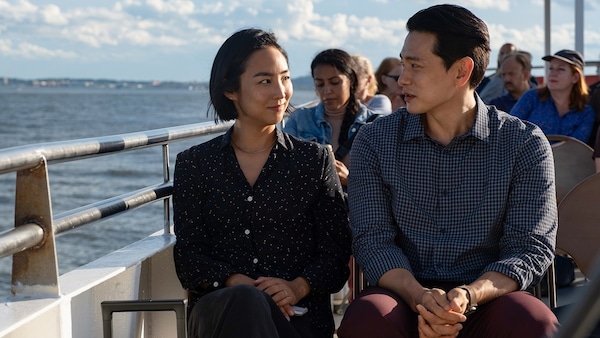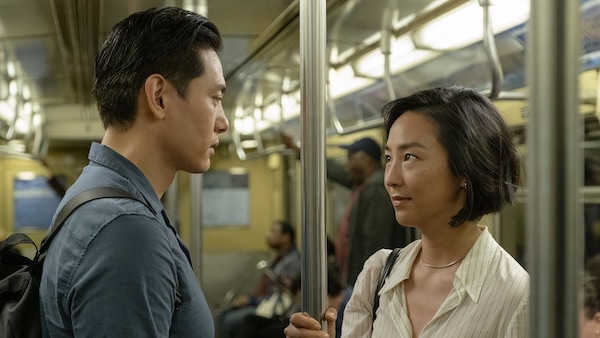Past Lives: Celine Song's Ode To All The Lives We'll Never Live
Past Lives is a love story of almosts, what-ifs, paths taken vs paths missed. Prahlad Srihari reviews.

Last Updated: 06.01 PM, Jul 07, 2023
AT the heart of Celine Song’s autofictional debut feature Past Lives is the Korean idea of in-yeon: a karmic connection that lets people cross each other’s paths over and over again, across several lifetimes. A rough translation would be fate. But fate doesn’t entirely cover it. If two neighbours brush past each other in a narrow alley (like in a Wong Kar-wai movie) or if two strangers meet aboard a train and spend the night falling in love (like in a Richard Linklater movie), in-yeon suggests it is a culmination of interactions over thousands of years. The idea isn’t exclusively romantic. Every person we come across in our lifetime, from our partners to the pizza delivery guy, is said to be someone we have interacted with in a past life.
In Past Lives, in-yeon brings together childhood sweethearts Nora (Greta Lee) and Hae Sung (Teo Yoo), only for destiny to pull them apart. This is a love story of almosts, what-ifs, paths taken vs paths missed. When Nora and Hae Sung reconnect in New York 24 years after the former’s family emigrated from South Korea, the question of the two ending up together is no longer a matter of distance, but the decisions that have put them on divergent paths. The biggest one for Nora being she is married, quite happily, to fellow writer Arthur (John Magaro).

Out of this scenario comes a light-footed contemplation of what could have been and what is. Song’s film localises a world of wistful ambivalence within two childhood sweethearts whose situation is sure to inspire bittersweet memories of that someone from our own childhood we can’t seem to forget. Each time we think of them, we can’t help but wonder about the alternate lives we might have lived. Song is keen to offset the romanticism of missed opportunities regained with pragmatism, recasting the vitality of young love with the reality of growing up. The idea of in-yeon may be the guiding force of the story, but even it is not immune to ironic scrutiny. Nora jokes that it’s “just something Koreans say to seduce someone,” implying the concept has been vulgarised to a come-on.
The present becomes pregnant with the past as Nora and Hae Sung see each other for the first time in two decades. Once the two get to talking, the conversations reveal how the missed chances of the past weigh heavily on both. Their instant connection kindles residual hope that they can yet reclaim the years lost. Lee and Yoo are so in tune it feels like their characters’ relationship runs deeper than the fiction that contains it, finding the truth of each moment in the ellipses and all that remains unspoken. Even when the two are not together, the film breathes an anticipatory air of reconnection.
For each, the other remains an idealised memory. In Hae Sung’s mind, Nora remains “Na Young”, the 12-year-old girl that got away. Though Nora has lived a lot longer in Canada and the US, she still dreams in Korean — an unconscious desire that speaks to immigrant anxiety over fractured identities and lives left behind. Nora is torn between the culture she has inherited and the culture she has integrated, between the life she knew and the life she knows now, between her first love and her husband.

As befits a protagonist wrestling with liminality, Song uses in-between spaces as settings: airports, hotels, trains, ferries and cabs. The settings serve as physical extensions of Nora’s itinerant state of mind. The city, parks and streets of New York and Seoul allow a visual springboard for Nora and Hae Sung to connect and reconnect. When a young Nora and Hae Sung walk home after school, a fork in the path presents the first sign of fate’s intervention. When the older Nora and Hae Sung walk around Coney Island, a carousel in the background gives the feeling of the two being pulled closer to each other. The forecast is for heavy rain all week but even the weather clears up in time for the reunion. Street signage hang over the couple like mistletoe. Shots frame the two against giant buildings and monuments that act as a constant reminder of their lives being governed by something much bigger. Song’s camera provides fluidity to her vision and lets a sense of longing bubble up as it follows Lee and Yoo like an unobtrusive third wheel. Christopher Bear and Daniel Rossen (of the indie-rock outfit Grizzly Bear) give sensorial form to paths crossing and fate intervening with a dreamy combination of strings and pianos, that is as attuned to the frisson of a fleeting moment as to the splendour of a decades-spanning will-they-won’t-they.
Every name in the opening credits and the title in the poster being separated is a hint in itself as to will they or won’t they question. The film opens with a cheekily self-aware scene: Nora is seated between Hae Sung and Arthur in a bar where an anonymous couple speculate how the three could be related. Are Nora and Hae Sung siblings or lovers? Or is Nora with Arthur and Hae Sung is their friend? Are Nora and Hae Sung tourists and Arthur their tour guide? At this point, Nora looks straight at the camera, as if to suggest the truth isn’t always what we expect, in a film that cleverly but sensitively plays around viewer expectations of love stories.

As children in Seoul, Nora and Hae Sung would walk home together, compete over class rankings, share their dreams, and even go on a chaperoned date at a local park — before Nora’s family decide to move to Toronto. Twelve years pass before the two reconnect over Facebook and freezing-and-lagging Skype calls. Nora is now a wannabe playwright; Hae Sung has just completed his conscription. But the two pick up where they left off, like two old friends not old enough to be scarred by the demands of adulthood. But the long distance puts a strain on the relationship which eventually fizzles out. Twelve more years flash by in a New York minute. Nora is married to Arthur when Hae Sung drops by for a visit. The reunion disrupts the comfortable life she has built with her husband who worries if he is the “white guy” keeping destined lovers apart.
But Nora knows whatever lingering feelings she has for Hae Sung — feelings no doubt inflated by nostalgia and decades-long expectations — are not worth jeopardising her marriage with a man she dearly loves. Hae Sung realises the Nora standing before him is not the Na Young from his childhood still trapped in the amber of his memory. Reconnecting provides closure for both. Maybe in another lifetime, the two may have been happily married with kids or happily divorced. It takes catching up and parting ways for both to understand and accept that sometimes it’s just not meant to be.
